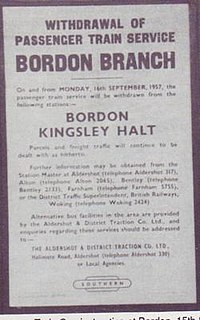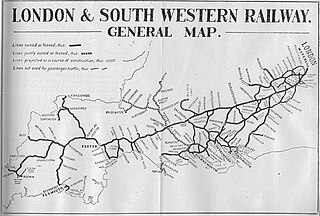
The London and South Western Railway was a railway company in England from 1838 to 1922. Originating as the London and Southampton Railway, its network extended to Dorchester and Weymouth, to Salisbury, Exeter and Plymouth, and to Padstow, Ilfracombe and Bude. It developed a network of routes in Hampshire, Surrey and Berkshire, including Portsmouth and Reading.

Bordon is a town in the East Hampshire district of Hampshire, England. It lies in the interior of the royal Woolmer Forest, about 5 miles (8.0 km) southeast of Alton. The town forms a part of the civil parish of Whitehill which is one of two contiguous villages, the other being Lindford. The civil parish is on the A325, and near the A3 road between London and Portsmouth, from which it is buffered by the rise of the wooded Woolmer Ranges. Bordon is twinned with Condé-sur-Vire in Normandy, France.

Bentley railway station serves the village of Bentley in Hampshire, England. It is situated on the Alton Line, between Farnham and Alton. The station and all trains serving it are operated by South Western Railway.

The Longmoor Military Railway (LMR) was a British military railway in Hampshire that was built by the Royal Engineers from 1903 to train soldiers on railway construction and operations. The railway ceased operation on 31 October 1969.

Brookwood is a National Rail railway station in Brookwood in the English county of Surrey. It is 27 miles 79 chains (45.0 km) down the line from London Waterloo.

Liss railway station is a stop on the Portsmouth Direct Line, serving the village of Liss in Hampshire, England, 51 miles 35 chains (82.8 km) down the line from London Waterloo via Woking. As a small station, for most of the day there is one train each way an hour. The station is managed by South Western Railway, which operates all trains serving it.
Sleaford in Hampshire, England is a hamlet of Headley Civil Parish and the Northanger Ecclesiastical Benefice. It is in the civil parish of Whitehill

The Basingstoke and Alton Light Railway was opened in 1901, by the London and South Western Railway. It was the first English railway authorised under Light Railway legislation. It ran through unpromising, lightly populated terrain, and was probably built only to exclude competitors from building a line in the area. It had steep gradients and a line speed limit of 20 mph, later raised to 25 mph.
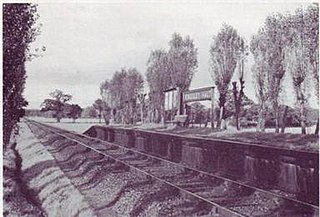
Kingsley Halt was a railway station on the Bordon Light Railway which served the village of Kingsley, Hampshire, England. The station had been constructed by the London and South Western Railway (LSWR) in the hope that the area would attract residential development, but this did not happen. The LSWR had purchased an area of land far larger than that what was actually used, as they hoped to construct a large station and goods yard. A primitive halt with a single platform opened some months after the line's opening, consisting merely of a nameboard, noticeboard, lamp and seat.
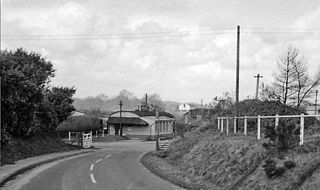
Bordon is a former railway station on the Bordon Light Railway which served the town of Bordon, Hampshire, England and its nearby army camp.
Whitehill is a village and civil parish in the East Hampshire district of Hampshire, England, on the historic route between Petersfield and Farnham. It is 0.7 miles (1.1 km) south of Bordon and covers an area of approximately 8 square miles.
The Salisbury branch line of the Great Western Railway from Westbury to Salisbury in Wiltshire, England, was completed in 1856. Most of the smaller stations were closed in 1955 but the line remains in use as part of the Wessex Main Line.
The Amesbury and Military Camp Light Railway was a branch line in Wiltshire, England, constructed under a light railway order dated 24 September 1898. It was opened for military traffic from Amesbury to the east-facing Newton Tony Junction on 1 October 1901. A west-facing junction, Amesbury Junction, where the branch burrowed under the main line, opened on 2 June 1902. The line closed in 1963.

Hogmoor Inclosure is a large area of wooded heath situated 0.5 miles (0.80 km) west from the town of Bordon and within the civil parish of Whitehill in the East Hampshire district of Hampshire, England. The inclosure is used for army training with various tank crossings scattered around the area. The area is historically notable for its connection with the British Army with large barracks surrounding the area.
Oakhanger Halt is a former railway station, on the Longmoor Military Railway which served Bordon Camp, the station was closer to the camp than Bordon on the Bordon Light Railway. The station is likely to have opened with the line in 1905 but the first documented evidence showing it open is on 14 August 1914 when it was used the Officer Commanding Railway Troops to say goodbye to the first mobilised Railway Company departing for France.
Weaversdown Halt railway station is a former railway station, on the Longmoor Military Railway, which served the eastern side of Longmoor Military Camp. The station did not appear on Ordnance Survey mapping throughout its life and did not have signs on the platform, it was variously known as Weaversdown, Weavers Down and Weaver Down sometimes with the additional Junction and sometimes with Halt.
Liss Forest Road railway station served the hamlet of Liss Forest neighbouring the larger village of Liss, in Hampshire. It is situated adjacent to Forest Road which runs from the A3 to Liss Forest. The road was crossed by a level crossing controlled by a block post, the Army's name for a signal box, which was usually un-staffed unless training was in progress.

Longmoor Downs railway station is a former railway station, on the Longmoor Military Railway serving Longmoor Military Camp. The station was the Southern terminus of the original standard gauge railway opened in stages between 1907 and 1908.
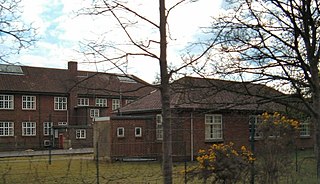
Longmoor Camp is a British Army camp close to the A3 and A325 roads in and around the settlements of Longmoor, Liss and Liphook in Hampshire, England. The main street of the Longmoor part of the camp is built on an ancient Roman road, the Chichester to Silchester Way, while the village of Greatham lies to the west. The combined camp and training area coveres 1,783 hectares of wooded areas, heath, wetlands and hard standings. Longmoor Camp and the training areas are still active, and maintained by the Defence Infrastructure Organisation.
The Aldershot and Alton lines of the LSWR were railways developed from 1849 onwards in the region in Surrey and Hampshire, England, between the Southampton main line and Guildford. First was a line from Guildford to Farnham, soon extended to Alton in 1852. The Reading, Guildford and Reigate Railway, an affiliate of the South Eastern Railway (SER), used part of that line by running powers. When the Aldershot Garrison and associated camps opened, suddenly Aldershot had a large population, both civilian and military, and the LSWR built a line from Pirbright Junction, on the Southampton main line. As well as serving Aldershot, this line gave a more direct route from London. It opened in 1870.
